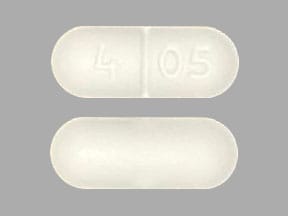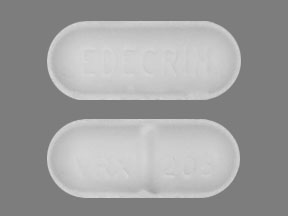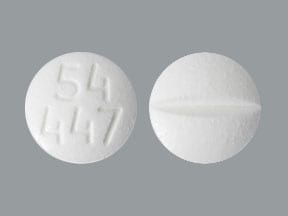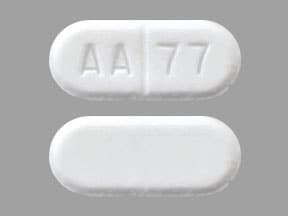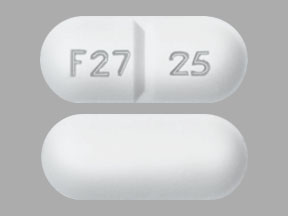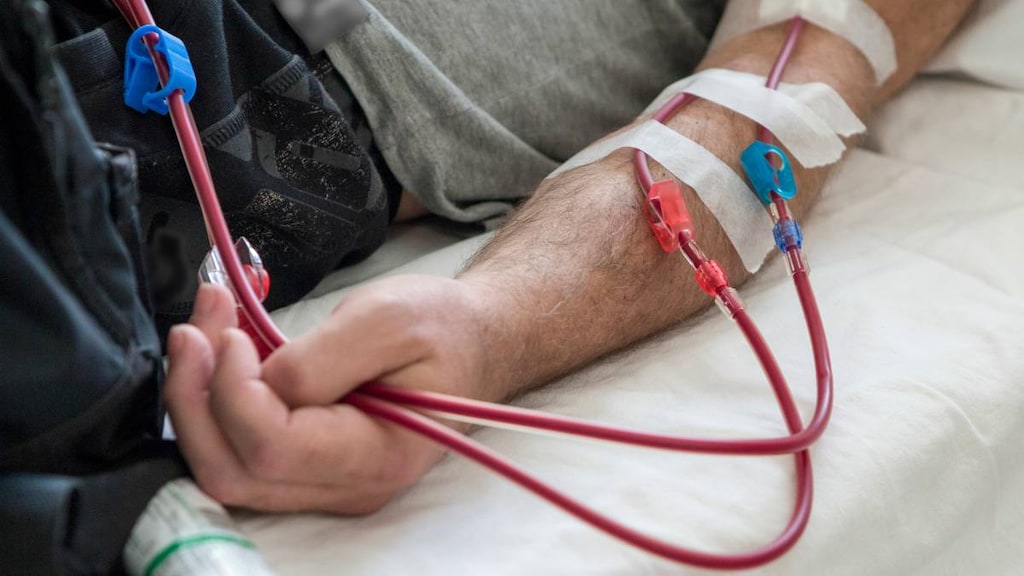Dosage Forms
Excipient information presented when available (limited, particularly for generics); consult specific product labeling.
Solution Reconstituted, Intravenous, as ethacrynate sodium:
Sodium Edecrin: 50 mg (1 ea)
Generic: 50 mg (1 ea)
Tablet, Oral:
Edecrin: 25 mg [scored]
Generic: 25 mg
Pharmacology
Mechanism of Action
Inhibits reabsorption of sodium and chloride in the ascending loop of Henle and distal renal tubule, interfering with the chloride-binding cotransport system, thus causing increased excretion of water, sodium, chloride, magnesium, and calcium
Pharmacokinetics/Pharmacodynamics
Absorption
Oral: Rapid
Metabolism
Hepatic (35% to 40%) to active cysteine conjugate
Excretion
Feces and urine (30% to 60% as unchanged drug)
Onset of Action
Diuresis: Oral: ~30 minutes; IV: 5 minutes; Peak effect: Oral: 2 hours; IV: 30 minutes
Duration of Action
Oral: 12 hours; IV: 2 hours
Half-Life Elimination
Normal renal function: 2-4 hours
Protein Binding
>90%
Use: Labeled Indications
Oral: Management of edema associated with congestive heart failure; hepatic cirrhosis or renal disease; short-term management of ascites due to malignancy, idiopathic edema, and lymphedema; short-term management of hospitalized pediatric patients, other than infants, with congenital heart disease or the nephrotic syndrome
IV: Indicated when a rapid onset of diuresis is desired (eg, in acute pulmonary edema, or when gastrointestinal absorption is impaired or oral medication is not feasible)
Contraindications
Hypersensitivity to ethacrynic acid or any component of the formulation; anuria; history of severe watery diarrhea caused by this product; infants
Dosage and Administration
Dosing: Adult
Note: Oral dose equivalency (approximate) for patients with normal renal function (Brater 1983; Cody 1994; Vargo 1995): Ethacrynic acid 50 mg = bumetanide 1 mg = torsemide 20 mg = furosemide 40 mg
Edema:
Oral: 50 to 200 mg/day in 1 to 2 divided doses; may increase in increments of 25 to 50 mg at intervals of several days to a maximum of 400 mg/24 hours.
IV: 0.5 to 1 mg/kg/dose (maximum: 100 mg/dose); repeat doses not routinely recommended; however, if indicated, repeat doses every 8 to 12 hours.
Dosing: Geriatric
Oral: Initial: 25 to 50 mg/day
Dosing: Pediatric
Note: Dose equivalency for adult patients with normal renal function (approximate): Bumetanide 1 mg = furosemide 40 mg = torsemide 20 mg = ethacrynic acid 50 mg
Edema (diuresis): Note: Ethacrynic acid is a potent diuretic and should be used for clinical conditions refractory to other diuretics, or requiring rapid onset in diuretic response.
Oral: Infants (limited data available), Children, and Adolescents: Initial: 1 mg/kg/dose once daily; maximum initial dose should generally not exceed 25 to 50 mg/dose based on experience in adult patients; increase at intervals of 2 to 3 days to a maximum of 3 mg/kg/day in divided doses 1 to 3 times daily not to exceed a maximum daily dose: 400 mg/24 hours (Park 2014)
Parenteral: Limited data available: Infants, Children, and Adolescents:
Intermittent IV: 0.5 to 1 mg/kg/dose every 8 to 24 hours; maximum dose: 50 mg/dose (Kliegman 2007; Park 2014)
Continuous IV infusion: Usual reported initial rate: 0.1 mg/kg/hour, titrate to effect; maximum reported infusion rate: 0.5 mg/kg/hour, although in trials, most patients responded to a lower dose. Dosing based on a prospective study of 36 pediatric post-operative cardiac surgery patients (mean age: 135 ± 181 days; mean weight: 4.2 ± 3.1 kg) which reported a mean effective dose of 0.22 ± 0.13 mg/kg/hour (Ricci 2015); a pilot retrospective report of 9 patients reported a mean initial dose 0.13 ± 0.07 mg/kg/hour and a mean maximum rate of 0.17 ± 0.08 mg/kg/hour (Miller 2014). Note: Monitor serum electrolytes closely; in trials, hypokalemia and metabolic alkalosis was frequently observed.
Reconstitution
IV formulation should be diluted in D5W or NS (1 mg/mL) and infused over several minutes.
Extemporaneously Prepared
A 1 mg/mL oral suspension may be made with ethacrynic acid powder. Dissolve 120 mg ethacrynic acid powder in a small amount of 10% alcohol. Add a small amount of 50% sorbitol solution and stir. Adjust pH to 7 with 0.1N sodium hydroxide solution. Add sufficient quantity of 50% sorbitol solution to make a final volume of 120 mL. Add methylparaben 6 mg and propylparaben 2.4 mg as preservatives. Stable for 220 days at room temperature.
Das Gupta V, Gibbs CW Jr, and Ghanekar AG, "Stability of Pediatric Liquid Dosage Forms of Ethacrynic Acid, Indomethacin, Methyldopate Hydrochloride, Prednisone and Spironolactone," Am J Hosp Pharm, 1978, 35(11):1382-5.568384Handbook on Extemporaneous Formulations, Bethesda, MD: American Society of Hospital Pharmacists, 1987.
Administration
IV: Injection should not be given SubQ or IM due to local pain and irritation. Single IV doses should not exceed 100 mg. Administer slowly through the tubing of a running infusion or by direct IV injection over a period of several minutes. If a second dose is needed, it is recommended to use a new injection site to avoid possible thrombophlebitis.
Dietary Considerations
This product may cause a potassium loss. Your healthcare provider may prescribe a potassium supplement, another medication to help prevent the potassium loss, or recommend that you eat foods high in potassium, especially citrus fruits. Do not change your diet on your own while taking this medication, especially if you are taking potassium supplements or medications to reduce potassium loss. Too much potassium can be as harmful as too little.
Storage
Store at 25°C (77°F); excursions permitted to 15°C to 30°C (59°F to 86°F). Discard unused reconstituted solution after 24 hours.
Ethacrynic Acid Images
Drug Interactions
Alfuzosin: May enhance the hypotensive effect of Blood Pressure Lowering Agents. Monitor therapy
Allopurinol: Loop Diuretics may enhance the adverse/toxic effect of Allopurinol. Loop Diuretics may increase the serum concentration of Allopurinol. Specifically, Loop Diuretics may increase the concentration of Oxypurinol, an active metabolite of Allopurinol. Monitor therapy
Amifostine: Blood Pressure Lowering Agents may enhance the hypotensive effect of Amifostine. Management: When amifostine is used at chemotherapy doses, blood pressure lowering medications should be withheld for 24 hours prior to amifostine administration. If blood pressure lowering therapy cannot be withheld, amifostine should not be administered. Consider therapy modification
Amikacin (Oral Inhalation): Loop Diuretics may enhance the nephrotoxic effect of Amikacin (Oral Inhalation). Loop Diuretics may enhance the ototoxic effect of Amikacin (Oral Inhalation). Monitor therapy
Aminoglycosides: Loop Diuretics may enhance the adverse/toxic effect of Aminoglycosides. Specifically, nephrotoxicity and ototoxicity. Monitor therapy
Amphetamines: May diminish the antihypertensive effect of Antihypertensive Agents. Monitor therapy
Angiotensin-Converting Enzyme Inhibitors: Loop Diuretics may enhance the hypotensive effect of Angiotensin-Converting Enzyme Inhibitors. Loop Diuretics may enhance the nephrotoxic effect of Angiotensin-Converting Enzyme Inhibitors. Monitor therapy
Antidiabetic Agents: Hyperglycemia-Associated Agents may diminish the therapeutic effect of Antidiabetic Agents. Monitor therapy
Antipsychotic Agents (Second Generation [Atypical]): Blood Pressure Lowering Agents may enhance the hypotensive effect of Antipsychotic Agents (Second Generation [Atypical]). Monitor therapy
Barbiturates: May enhance the hypotensive effect of Blood Pressure Lowering Agents. Monitor therapy
Benperidol: May enhance the hypotensive effect of Blood Pressure Lowering Agents. Monitor therapy
Beta2-Agonists: May enhance the hypokalemic effect of Loop Diuretics. Monitor therapy
Bilastine: Loop Diuretics may enhance the QTc-prolonging effect of Bilastine. Monitor therapy
Bile Acid Sequestrants: May decrease the absorption of Loop Diuretics. Consider therapy modification
Brigatinib: May diminish the antihypertensive effect of Antihypertensive Agents. Brigatinib may enhance the bradycardic effect of Antihypertensive Agents. Monitor therapy
Brimonidine (Topical): May enhance the hypotensive effect of Blood Pressure Lowering Agents. Monitor therapy
Bromperidol: Blood Pressure Lowering Agents may enhance the hypotensive effect of Bromperidol. Bromperidol may diminish the hypotensive effect of Blood Pressure Lowering Agents. Avoid combination
Canagliflozin: May enhance the hypotensive effect of Loop Diuretics. Management: If canagliflozin is combined with a loop diuretic, monitor for symptoms of intravascular volume depletion and hypotension. Canadian product labeling recommends avoiding the combination of canagliflozin and loop diuretics. Consider therapy modification
Cardiac Glycosides: Loop Diuretics may enhance the adverse/toxic effect of Cardiac Glycosides. Specifically, cardiac glycoside toxicity may be enhanced by the hypokalemic and hypomagnesemic effect of loop diuretics. Monitor therapy
Cefazedone: May enhance the nephrotoxic effect of Loop Diuretics. Monitor therapy
Cefotiam: Loop Diuretics may enhance the nephrotoxic effect of Cefotiam. Monitor therapy
Cefpirome: Loop Diuretics may enhance the nephrotoxic effect of Cefpirome. Monitor therapy
Ceftizoxime: Loop Diuretics may enhance the nephrotoxic effect of Ceftizoxime. Monitor therapy
Cephalothin: Loop Diuretics may enhance the nephrotoxic effect of Cephalothin. Monitor therapy
Cephradine: May enhance the nephrotoxic effect of Loop Diuretics. Monitor therapy
CISplatin: Loop Diuretics may enhance the nephrotoxic effect of CISplatin. Loop Diuretics may enhance the ototoxic effect of CISplatin. Monitor therapy
Corticosteroids (Orally Inhaled): May enhance the hypokalemic effect of Loop Diuretics. Monitor therapy
Corticosteroids (Systemic): May enhance the hypokalemic effect of Loop Diuretics. Monitor therapy
CycloSPORINE (Systemic): May enhance the adverse/toxic effect of Loop Diuretics. Monitor therapy
Desmopressin: Loop Diuretics may enhance the hyponatremic effect of Desmopressin. Avoid combination
Dexmethylphenidate: May diminish the therapeutic effect of Antihypertensive Agents. Monitor therapy
Diacerein: May enhance the therapeutic effect of Diuretics. Specifically, the risk for dehydration or hypokalemia may be increased. Monitor therapy
Diazoxide: May enhance the hypotensive effect of Blood Pressure Lowering Agents. Monitor therapy
Dichlorphenamide: Loop Diuretics may enhance the hypokalemic effect of Dichlorphenamide. Monitor therapy
Dofetilide: Loop Diuretics may enhance the QTc-prolonging effect of Dofetilide. Management: Monitor serum potassium and magnesium more closely when dofetilide is combined with loop diuretics. Some therapy modification may be required. Consider therapy modification
DULoxetine: Blood Pressure Lowering Agents may enhance the hypotensive effect of DULoxetine. Monitor therapy
Empagliflozin: May enhance the hypotensive effect of Loop Diuretics. Monitor therapy
Fexinidazole [INT]: May enhance the arrhythmogenic effect of Loop Diuretics. Avoid combination
Foscarnet: Loop Diuretics may increase the serum concentration of Foscarnet. Consider therapy modification
Fosphenytoin: May diminish the diuretic effect of Loop Diuretics. Monitor therapy
Furosemide: May enhance the ototoxic effect of Ethacrynic Acid. Avoid combination
Herbs (Hypertensive Properties): May diminish the antihypertensive effect of Antihypertensive Agents. Monitor therapy
Herbs (Hypotensive Properties): May enhance the hypotensive effect of Blood Pressure Lowering Agents. Monitor therapy
Hypotension-Associated Agents: Blood Pressure Lowering Agents may enhance the hypotensive effect of Hypotension-Associated Agents. Monitor therapy
Ipragliflozin: May enhance the adverse/toxic effect of Loop Diuretics. Specifically, the risk for intravascular volume depletion may be increased. Monitor therapy
Ivabradine: Loop Diuretics may enhance the arrhythmogenic effect of Ivabradine. Monitor therapy
Levodopa-Containing Products: Blood Pressure Lowering Agents may enhance the hypotensive effect of Levodopa-Containing Products. Monitor therapy
Levosulpiride: Loop Diuretics may enhance the adverse/toxic effect of Levosulpiride. Avoid combination
Licorice: May enhance the hypokalemic effect of Loop Diuretics. Monitor therapy
Lithium: Loop Diuretics may decrease the serum concentration of Lithium. Loop Diuretics may increase the serum concentration of Lithium. Monitor therapy
Lormetazepam: May enhance the hypotensive effect of Blood Pressure Lowering Agents. Monitor therapy
Methotrexate: May diminish the therapeutic effect of Loop Diuretics. Loop Diuretics may increase the serum concentration of Methotrexate. Methotrexate may increase the serum concentration of Loop Diuretics. Management: Monitor for increased methotrexate and/or loop diuretic levels/toxicity with concomitant use of these agents and monitor for decreased therapeutic effects of loop diuretics. Methotrexate and/or loop diuretic dose reductions may be necessary. Consider therapy modification
Methylphenidate: May diminish the antihypertensive effect of Antihypertensive Agents. Monitor therapy
Molsidomine: May enhance the hypotensive effect of Blood Pressure Lowering Agents. Monitor therapy
Naftopidil: May enhance the hypotensive effect of Blood Pressure Lowering Agents. Monitor therapy
Neuromuscular-Blocking Agents: Loop Diuretics may diminish the neuromuscular-blocking effect of Neuromuscular-Blocking Agents. Loop Diuretics may enhance the neuromuscular-blocking effect of Neuromuscular-Blocking Agents. Monitor therapy
Nicergoline: May enhance the hypotensive effect of Blood Pressure Lowering Agents. Monitor therapy
Nicorandil: May enhance the hypotensive effect of Blood Pressure Lowering Agents. Monitor therapy
Nitroprusside: Blood Pressure Lowering Agents may enhance the hypotensive effect of Nitroprusside. Monitor therapy
Nonsteroidal Anti-Inflammatory Agents: May diminish the diuretic effect of Loop Diuretics. Loop Diuretics may enhance the nephrotoxic effect of Nonsteroidal Anti-Inflammatory Agents. Management: Monitor for evidence of kidney injury or decreased therapeutic effects of loop diuretics with concurrent use of an NSAID. Consider avoiding concurrent use in CHF or cirrhosis. Concomitant use of bumetanide with indomethacin is not recommended. Consider therapy modification
Obinutuzumab: May enhance the hypotensive effect of Blood Pressure Lowering Agents. Management: Consider temporarily withholding blood pressure lowering medications beginning 12 hours prior to obinutuzumab infusion and continuing until 1 hour after the end of the infusion. Consider therapy modification
Opioid Agonists: May enhance the adverse/toxic effect of Diuretics. Opioid Agonists may diminish the therapeutic effect of Diuretics. Monitor therapy
Pentoxifylline: May enhance the hypotensive effect of Blood Pressure Lowering Agents. Monitor therapy
Phenytoin: May diminish the diuretic effect of Loop Diuretics. Monitor therapy
Pholcodine: Blood Pressure Lowering Agents may enhance the hypotensive effect of Pholcodine. Monitor therapy
Phosphodiesterase 5 Inhibitors: May enhance the hypotensive effect of Blood Pressure Lowering Agents. Monitor therapy
Probenecid: May enhance the adverse/toxic effect of Loop Diuretics. Probenecid may diminish the diuretic effect of Loop Diuretics. Probenecid may increase the serum concentration of Loop Diuretics. Management: Monitor for decreased diuretic effects or increased adverse effects of loop diuretics with concomitant use of probenecid. Bumetanide prescribing information recommends against concomitant use of probenecid. Monitor therapy
Promazine: Loop Diuretics may enhance the QTc-prolonging effect of Promazine. Avoid combination
Prostacyclin Analogues: May enhance the hypotensive effect of Blood Pressure Lowering Agents. Monitor therapy
Quinagolide: May enhance the hypotensive effect of Blood Pressure Lowering Agents. Monitor therapy
Reboxetine: May enhance the hypokalemic effect of Loop Diuretics. Monitor therapy
RisperiDONE: Loop Diuretics may enhance the adverse/toxic effect of RisperiDONE. Monitor therapy
Salicylates: May diminish the diuretic effect of Loop Diuretics. Loop Diuretics may increase the serum concentration of Salicylates. Monitor therapy
Sodium Phosphates: Diuretics may enhance the nephrotoxic effect of Sodium Phosphates. Specifically, the risk of acute phosphate nephropathy may be enhanced. Management: Consider avoiding this combination by temporarily suspending treatment with diuretics, or seeking alternatives to oral sodium phosphate bowel preparation. If the combination cannot be avoided, hydrate adequately and monitor fluid and renal status. Consider therapy modification
Tobramycin (Oral Inhalation): Loop Diuretics may enhance the nephrotoxic effect of Tobramycin (Oral Inhalation). Loop Diuretics may enhance the ototoxic effect of Tobramycin (Oral Inhalation). Monitor therapy
Topiramate: Loop Diuretics may enhance the hypokalemic effect of Topiramate. Monitor therapy
Vitamin K Antagonists (eg, warfarin): Ethacrynic Acid may increase the serum concentration of Vitamin K Antagonists. Monitor therapy
Xipamide: May enhance the adverse/toxic effect of Loop Diuretics. Specifically, the risk of hypovolemia, electrolyte disturbances, and prerenal azotemia may be increased. Monitor therapy
Yohimbine: May diminish the antihypertensive effect of Antihypertensive Agents. Monitor therapy
Test Interactions
May lead to false-negative aldosterone/renin ratio (ARR) (Funder 2016).
Adverse Reactions
Frequency not defined.
Cardiovascular: Thrombophlebitis (with intravenous use)
Central nervous system: Apprehension, brain disease (patients with preexisting liver disease), chills, confusion, fatigue, headache, vertigo
Dermatologic: IgA vasculitis (in patient with rheumatic heart disease), skin rash
Endocrine & metabolic: Abnormal phosphorus levels (variations), abnormal serum calcium (variations), gout, hyperglycemia, hyperuricemia (reversible), hypoglycemia (occurred in two uremic patients who received doses above those recommended), hyponatremia, variations in bicarbonate, variations in CO2 content
Gastrointestinal: Abdominal distress, abdominal pain, anorexia, diarrhea, dysphagia, gastrointestinal hemorrhage, malaise, nausea, vomiting, acute pancreatitis (rare)
Genitourinary: Hematuria
Hematologic & oncologic: Agranulocytosis, severe neutropenia, thrombocytopenia
Hepatic: Abnormal hepatic function tests, jaundice
Local: Local irritation, local pain
Ophthalmic: Blurred vision
Otic: Deafness (temporary or permanent), tinnitus
Renal: Increased serum creatinine
Miscellaneous: Fever
Warnings/Precautions
Concerns related to adverse effects:
- Fluid/electrolyte loss: Loop diuretics are potent diuretics; excess amounts can lead to profound diuresis with fluid and electrolyte loss; close medical supervision and dose evaluation are required. Watch for and correct electrolyte disturbances; adjust dose to avoid dehydration. In contrast to thiazide diuretics, a loop diuretic can also lower serum calcium concentrations. Electrolyte disturbances can predispose a patient to serious cardiac arrhythmias.
- Hypersensitivity reactions: Can rarely occur, however, ethacrynic acid has no cross-reactivity to sulfonamides or sulfonylureas.
- Nephrotoxicity: Monitor fluid status and renal function in an attempt to prevent oliguria, azotemia, and reversible increases in BUN and creatinine; close medical supervision of aggressive diuresis required.
- Ototoxicity: Rapid IV administration, renal impairment, excessive doses, and concurrent use of other ototoxins is associated with ototoxicity; has been associated with a higher incidence of ototoxicity than other loop diuretics.
Disease-related concerns:
- Bariatric surgery: Dehydration: Avoid diuretics in the immediate postoperative period after bariatric surgery; electrolyte disturbances and dehydration may occur. Diuretics may be resumed, if indicated, once oral fluid intake goals are met (Ziegler 2009).
- Cirrhosis: In cirrhosis, avoid electrolyte and acid/base imbalances that might lead to hepatic encephalopathy.
Concurrent drug therapy issues:
- Antihypertensives: Coadministration of antihypertensives may increase the risk of hypotension.
Special populations:
- Surgical patients: If given the morning of surgery, ethacrynic acid may render the patient volume depleted and blood pressure may be labile during general anesthesia.
Other warnings and precautions:
- Diuretic resistance: For some patients, despite higher doses of loop diuretic treatment, an adequate diuretic response cannot be attained. Diuretic resistance can usually be overcome by intravenous administration, the use of two diuretics together (eg, furosemide and chlorothiazide), or the use of a diuretic with a positive inotropic agent. When such combinations are used, serum electrolytes need to be monitored even more closely (Cody 1994; ACC/AHA [Yancy 2013]; HFSA 2010).
Monitoring Parameters
Blood pressure, renal function, serum electrolytes, and fluid status closely, including weight and I & O daily; hearing
Pregnancy
Pregnancy Risk Factor
B
Pregnancy Considerations
Adverse events have not been observed in animal reproduction studies.
Patient Education
What is this drug used for?
- It is used to get rid of extra fluid.
- It may be given to you for other reasons. Talk with the doctor.
Frequently reported side effects of this drug
- Loss of strength and energy
- Headache
- Lack of appetite
- Vomiting
- Nausea
Other side effects of this drug: Talk with your doctor right away if you have any of these signs of:
- Fluid and electrolyte problems like mood changes, confusion, muscle pain or weakness, abnormal heartbeat, severe dizziness, passing out, fast heartbeat, increased thirst, seizures, loss of strength and energy, lack of appetite, unable to pass urine or change in amount of urine passed, dry mouth, dry eyes, or nausea or vomiting.
- High blood sugar like confusion, fatigue, increased thirst, increased hunger, passing a lot of urine, flushing, fast breathing, or breath that smells like fruit.
- Severe dizziness
- Passing out
- Trouble/loss of hearing
- Noise or ringing in the ears
- Vision changes
- Chills
- Burning or numbness feeling
- Vomiting blood
- Black, tarry, or bloody stools
- Blood in the urine
- Confusion
- Severe diarrhea
- Signs of a significant reaction like wheezing; chest tightness; fever; itching; bad cough; blue skin color; seizures; or swelling of face, lips, tongue, or throat.
Note: This is not a comprehensive list of all side effects. Talk to your doctor if you have questions.
Consumer Information Use and Disclaimer: This information should not be used to decide whether or not to take this medicine or any other medicine. Only the healthcare provider has the knowledge and training to decide which medicines are right for a specific patient. This information does not endorse any medicine as safe, effective, or approved for treating any patient or health condition. This is only a brief summary of general information about this medicine. It does NOT include all information about the possible uses, directions, warnings, precautions, interactions, adverse effects, or risks that may apply to this medicine. This information is not specific medical advice and does not replace information you receive from the healthcare provider. You must talk with the healthcare provider for complete information about the risks and benefits of using this medicine.
